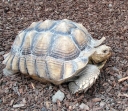African Spurred Tortoise (Centrochelys sulcata)
Classification: Introduced Species - While the African Spurred Tortoise has been seen and identified in numerous states at this time there are no records of any breeding populations in the wild. Sightings of this species are most likely of released or escaped pets that were imported for the pet trade.
Description: The spurred tortoise is sand-colored with an oval carapace, or shell. Its name comes from the overlapping scales on the front of its forelimbs and the 2-3 cone-shaped spurs on each thigh. The carapace of adults averages 18 inches in length, but can be as much as 2 or 3 feet long. These tortoises weigh an average of 70-100 pounds, but can weigh up to 200 pounds.
Carapace is broad, flattened and of a tan or brown color, with darker brown growth rings bordering the scutes. The anterior and posterior marginals are serrated and slightly upturned. Plastron is ivory to light tan in color, with paired forked gulars. Head and limbs are the same color as the shell and are protected with thick scales. Has one or more enlarged, conical spurs (or tubercles) on the upper hind limbs.
Habitat: The African spurred tortoise lives in semi-arid grasslands, scrub and savannah areas along the southern edge of the Sahara Desert in Northern Africa.
Range: Introduced into several states in the United States. Natural Range: The African spurred tortoise is native to the Sahara Desert and the Sahel, a transitional ecoregion of semiarid grasslands, savannas, and thorn shrublands found in the countries of Burkina Faso, the Central African Republic, Chad, Eritrea, Ethiopia, Mali, Mauritania, Nigeria, Senegal, Saudi Arabia, Sudan, Yemen and possibly in Somalia, Algeria, Benin, and Cameroon. It is possibly extirpated from Djibouti and Togo.
Diet: Sulcata tortoises are herbivores. Mixed grasses, edible flowers, certain weeds and very small amounts of grocery store produce are recommended for captive tortoises. Any animal protein of large amounts of vegetable protein will cause carapace deformity and a shortened life span. In the wild they rely on succulent plants for food as well as most of their water.
Reproduction:Copulation takes place right after the rainy season, during the months from September through November. Males combat each other for breeding rights with the females and are vocal during copulation. Sixty days after mating, the female begins to roam looking for suitable nesting sites.[3] For five to fifteen days, four or five nests may be excavated before she selects the perfect location in which the eggs will be laid.
Loose soil is kicked out of the depression, and the female may frequently urinate into the depression. Once it reaches about two feet in diameter and 3 to 6 inches deep, a further depression, measuring some eight inches across and in depth, will be dug out towards the back of the original depression. The work of digging the nest may take up to five hours; the speed with which it is dug seems to be dependent upon the relative hardness of the ground. It usually takes place when the ambient air temperature is at least 78℉. Once the nest is dug, the female begins to lay an egg every three minutes. Clutches may contain 15–30 or more eggs. After the eggs are laid, the female fills in the nest, taking an hour or more to fully cover them all. Incubation should be 86 to 88℉ and will take from 90 to 120 days.
Status: Many populations of C. sulcata are rapidly disappearing, especially in Mali, Chad, Niger, and Ethiopia. In Senegal there are still limited populations in the north and north-east, but there is a lot of overgrazing and desertification here too that is wiping this tortoise out.
»» Kingdom: Animalia - Animals
»» Phylum: Chordata - Chordates
»» Subphylum: Vertebrata - Vertebrates
»» Class: Reptilia - Reptiles
»» Order: Testudines - Turtles & Tortoises
»» Family: Testudinidae - Tortoises
»» Genus: Centrochelys
»» Species: Centrochelys sulcata - African Spurred Tortoise
»» Subspecies: None
This article uses material from the Wikipedia article "African Spurred Tortoise", which is released under the Creative Commons Attribution-Share-Alike License 3.0. Content may have been omitted from the original, but no content has been changed or extended.
|







